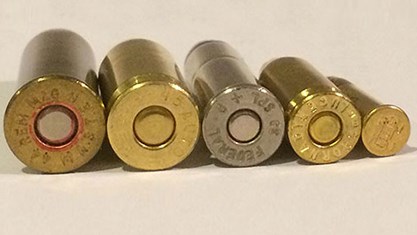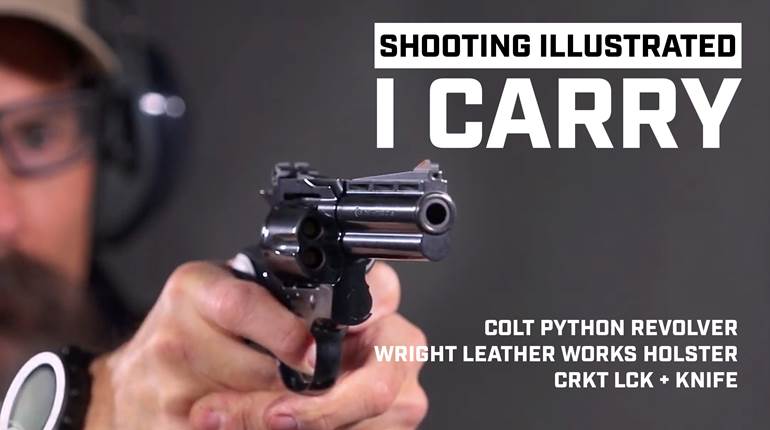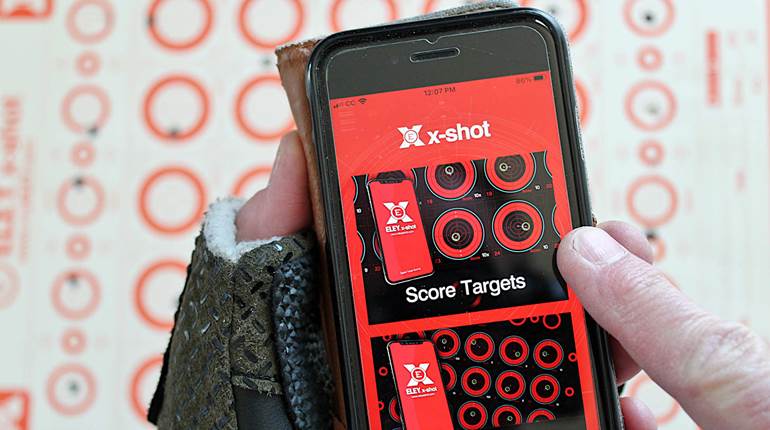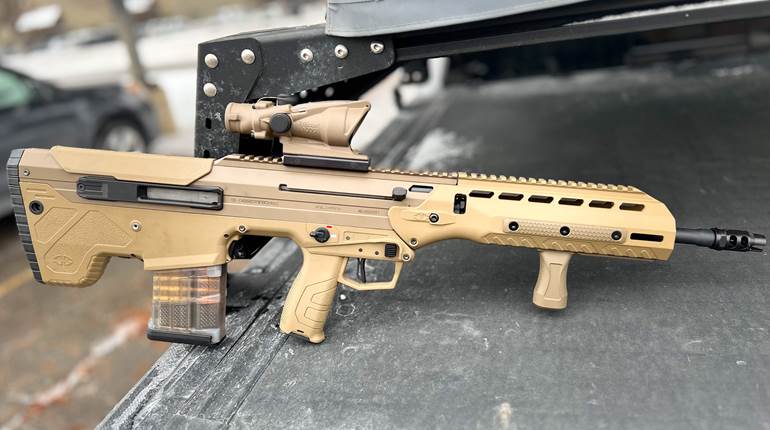
The author struck a chord with readers when he published his idea of the "Top Five Sporting Cartridges" of all time, so much so that comments continue to pour in. Thus he's decided to keep the spirited conversation going by identifying what he calls "America's Top Five Handgun Cartridges."
.22 Long Rifle
I was somewhat justifiably pilloried for not including this perennial cartridge in the original piece. There is no denying the .22 LR is the most popular sporting cartridge in the United States, perhaps even the world. The .22 LR is the result of the marriage of the .22 Long case developed in 1871 and the 40-grain, .22 Extra Long bullet. This marriage came about in 1887, and it rendered both parent cartridges obsolete nearly immediately. More than a billion rounds are produced worldwide annually, and until recently here in the U.S., it has been readily available and dirt cheap.
Small-game hunters and plinkers love the cartridge because of its lack of recoil and noise. The .22 LR is used regularly for short-range pest and varmint shooting on animals as small as ground squirrels and up to coyote in size, though coyote may be stretching it a bit. It is as equally at home in a revolver or a semi-automatic pistol. And accuracy in either platform is superb. I have a pair each of revolvers and semi-autos in this rimfire wonder cartridge, and each sees regular use throughout the year.
.38 Special/.357 Magnum
I choose to combine these two because essentially they are from the same case-the .357 Mag. being just 0.10-inch longer-and represent two distinct power levels in the same cartridge. Interestingly, this is one cartridge that was never a primary U.S. military cartridge, though the parent case-.38 Long Colt-was for a short time. The .38 Spl. came about in 1898 from the efforts of Smith & Wesson and its new Hand Ejector revolver to provide a relatively lightweight handgun with enough stopping power. While the military did not embrace the cartridge or the revolver, police agencies and sportsmen did.
The .38 Spl. and the double-action revolver became the mainstay of a majority of law enforcement agencies for the better part of the 20th century. It really didn't offer much of an upgrade in stopping power until later on when powder and bullet technology improved, but it was and remains a very accurate cartridge that almost any shooter can handle effectively. In 1935 Smith & Wesson, at the behest of Phil Sharpe and a few others, gave the cartridge a real power boost by lengthening the case and cramming it full of a slow, progressive burning powder and jacketed soft-point bullets. They christened it the .357 Magnum, and while many of today's sophisticated handgunners may poo-poo the .357 Mag. as a big-game cartridge, Douglass Wesson took one and ran around the world slaying everything from antelope to walrus with it. Today the .38 Spl./.357 Mag. is as popular as ever. Almost every dedicated revolver enthusiast has at least one or two examples in his or her collection.

9 mm Parabellum
I really would rather have not included the 9 mm Parabellum to this list for two reasons: One, it's not an American cartridge, and two, I am not much of a fan of it. However, I must be in a decided minority because it-like the .38 Special and .22 LR-has become wildly popular throughout the world. More precisely called the 9x19 mm but normally just called 9 mm (in polite society) it was the brainchild of Georg Luger in 1902 for his famous and beautiful, but hopelessly complex and fragile, semi-automatic pistol. Parabellum, by the way, is derived from the Latin phrase: Si vis pacem, para bellum (If you seek peace, prepare for war), which was the motto of Deutsche Waffen- und Munitionsfabriken (DWM), the company that produced the pistol and cartridge.
Like most cartridges developed for semi-automatic pistols, the 9 mm was cursed initially with round-nose, full-metal-jacketed (FMJ) bullets in order to function reliably in such mechanisms. While it may be reliable and relatively accurate, all FMJs-regardless of caliber-are notoriously ineffective on humans or animals unless bone is hit and shattered. Bullet technology has made a tremendous evolution, and today's bullets-even in 9 mm-are far better at transmitting energy into the target. Nonetheless, old-schoolers like me are fond of reiterating the old saw, "People who have been shot with a 9 mm have been known to get angry and resort to violent behavior." And the more modern dissing, "A 9 mm may expand, but a .45 never shrinks." But we are a dying breed, and the 9 mm continues to gain popularity 112 years after its introduction-mostly because it is the military cartridge of so many nations, including the United States. I should note that the U.S. is looking at replacing the 9 mm because of the first of the elderly admonitions regarding the cartridge.
.44 Special/.44 Magnum
Ah, back to my favorites. The .44 Smith & Wesson Special was introduced in 1907 as a way to cram more power in its N-frame New Century revolver-more commonly known as the Triple Lock. The .44 Spl. came from the loins of the .44 Russian; .19-inch longer than the parent case. This was part of the evolution from black powder to smokeless powder. Unfortunately, original loadings-some that carry over even today-mimic the old Russian load ballistically. As slower, progressive-burning powders were developed, a group of handgunners began stuffing .44 Spl. cases with these powders and topping them with bullets with large, flat meplats. These new loadings got people to stand up and take notice. Led primarily by a cowboy from Idaho named Elmer Keith, handgunners were wooed by stories of critters getting flattened regularly by what Keith referred to as "my heavy loads."
Keith kept badgering ammo companies to bring out his "heavy loads" in a factory load. Eventually Remington teamed up with Smith & Wesson to bring out what we know now as the .44 Remington Magnum in 1956. From its inception until relatively recently, the .44 Mag. was considered quite a handful-too much, in fact, for anyone but a well-seasoned handgunner. The cartridge's popularity soared with the 1971 film "Dirty Harry," which featured Clint Eastwood as a San Francisco inspector who packed the big gun. The Model 29 Smith & Wesson in .44 Mag. was actually the star of the film. Seemed everybody had to have one, and black-market prices went through the roof. After a cylinder of magnum loads, many shooters went for the lighter .44 Spl. ammunition.
Today both the .44 Spl. and its larger magnum brother remain very popular. Smith & Wesson, Colt and Ruger all make .44 Spl. revolvers-single and double action. Nearly every revolver maker makes some iteration of the .44 Mag. as well. I've used both chamberings on several deer and wild pigs, both launching the same Lyman 429421 cast semi-wadcutter-invented by Keith, by the way-and have never found either to be lacking on game.
.45 ACP
Last, but certainly not least, is the cartridge that John Browning came up with to replace the .38 Long Colt as a pistol cartridge for the U.S. military-the .45 Automatic Colt Pistol, or as it is more commonly known as the .45 ACP. The .45 ACP and the iconic pistol it was introduced in-the 1911-replicated the stopping power of the old .45 Colt cartridge in a case suited for the then-new semi-automatic pistols that enamored the military. In the mid- to late-1970s the .45 ACP and the 1911 began a surge in popularity in law enforcement circles, due in no small part to the writings of Col. Jeff Cooper, considered to be the father of the Modern Pistol Technique.
The largest drawback to the .45 ACP is the fact that it is so large in diameter that pistols with double-column magazines that are the rage with many of today's shooters are too wide to manipulate by anyone who doesn't have hands the size of a fielder's glove. Much of the current thinking contends that everyone who packs a self-defense sidearm must be prepared to deal with a Miami- or West Hollywood-style shootout where dozens of rounds are needed to cease hostilities-hence the attractiveness of the nines and forty calibers. Proponents of new cartridges and bullet technologies usually compare the effectiveness of their cartridge's and bullet's performance to that of the .45 ACP. Nevertheless many of us still cling to the 103-year-old cartridge and the pistol for what it is chambered.
Well there you have it-my list. I had to leave out two of my favorites, the .44-40 WCF and the .45 Colt to be able to include the 9 mm Parabellum. But I based my list on popularity and effectiveness. As it was with Top 5 Sporting Cartridges, you will no doubt let me know what you consider your favorite handgun cartridge.






































